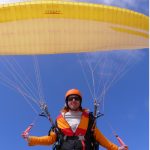Become a better paraglider pilot understanding micro-meteorology
As a paraglider pilot, Understanding certain micrometeorology principles is extremely important because they directly affect the quality and security of your flight.
Your familiarity with the weather will increase with experience. Nevertheless, as with any discipline, you should be curious about it and you should already be observing your environment in order to better understand it but also later to be capable of evaluating current and projected weather conditions so that you know when to fly and when to stay
grounded.
Lift is the fuel for paragliders
Now we know that the air we're flying through is in perpetual motion and that there is no such thing as perfectly calm air. Disturbed and chaotic air currents, called turbulence, can occur as can more orderly updrafts of air cause lift.
The lift enables you to keep flying your paraglider for long periods of time. There are two main types of lift: Dynamic lift is created as wind flows over hills and mountains. Thermal lift is caused by radiant heat emanating from the ground.
Soaring dynamic lift for paragliders
First, let's look at what causes the dynamic lift. When an air mass cannot go around an obstacle, such as a mountain, but is forced to pass over it, instead the wind that climbs up over the obstacle creates a dynamic lift.
Unfortunately for us all obstacles and the air streams they generate do not create exploitable dynamic lift for paragliders. In order to create good dynamic lift three conditions are required:
First, the airstream must be as perpendicular as possible to the obstacle. Secondly, the wind mustn't blow too strongly, otherwise, it'll become turbulent as it travels uphill. Lastly, the shape of the obstacle; the shape of the obstacle is essential because the air will always find the shortest means of overcoming the obstacle.
In the case of this conical hill shaped obstacle, the wind follows the most direct route around its sides. In the case of a sufficiently wide and reasonably high landform, the wind stream climbs over it and lift is produced just before its summit.
Let's look at how an airstream advances uphill and downhill: it's important that paragliders pilots understand this phenomenon not only to make better use of the lift but also to avoid the hazardous areas. A lift originated on the windward side of the mount near its summit the higher you ascend in the lift zone, the weaker the lift becomes.
To take advantage of the lift when you fly your paraglider, you should make figure eights parallel to the ridge, making sure to turn with your back towards the elevated ground.
On the leeward side, things are completely different: the airstream does not create upward lift but rather downward moving air currents that are very turbulent. The further you descend into this zone the stronger the downdraft becomes. The presence of turbulence makes flying in these areas extremely unadvised.
Thermal lift in free flight
Flying through dynamic lift will result in your first long-lasting flights. Taking advantage of this kind of lift is not difficult it will give you the chance to get used to piloting your paraglider so that you will be better prepared for thermal lift.
Thermal lift is another way to make your paragliding flights last longer. Warm, invisible air masses of different sizes will lift and carry paragliders up into the clouds.
We're not going to give you a detailed technical explanation on how to take advantage of a thermal lift nor how to fly in thermal lift conditions, however, we do want to provide you with some essential information that will be useful to you later on.
Power thermals formed: remember back to the different energy transfers we
discussed earlier? Thanks to radiant energy from the Sun, the ground is heated up it should be noted though that this depends on the terrain; for example, a ground covered
with snow will reflect more than 3/4 of the radiant heat as opposed to absorbing it.
Afterwards, the ground will conduct its accumulated heat to the air directly above it. That heated layer of air will become warmer than the air around it and has it warms it becomes less dense and inevitably rises through.
Convection: a difference of two degrees is all that's needed to make this pocket of warm air rise.
If certain pressure and humidity conditions reunited a cumulus cloud will form at the top of the lift. As soon as the lift stops the cloud is no longer supplied and it will eventually disappear.
For paraglider pilots, the cumulus is the king of clouds; it is the sign of good flying conditions and above all, it indicates the presence of thermal lift.
This post is a transcription of the video "Learn to Fly" (Kitchen Productions)
















